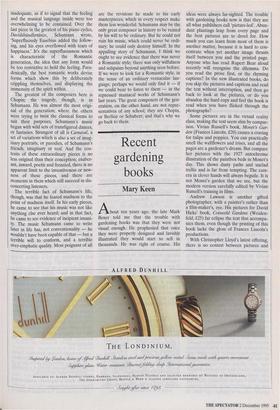Recent gardening books
Mary Keen
About ten years ago, the late Mark Boxer told me that the trouble with gardening books was that they were not visual enough. He prophesied that once they were properly designed and lavishly illustrated they would start to sell in thousands. He was right of course. His ideas were always far-sighted. The trouble with gardening books now is that they are all what publishers call 'picture-led'. Abun- dant plantings leap from every page and the best pictures are to drool for. How much you can learn from most of them is another matter, because it is hard to con- centrate when yet another image thrusts itself between you and the printed page. Anyone who has read Rupert Bear aloud recently will recognise the dilemma. Do you read the prose first, or the rhyming captions? In the new illustrated books, do you skip the pictures and captions and read the text without interruption, and then go back to look at the pictures, or do you abandon the hard copy and feel the book is read when you have flicked through the photographs?
Some pictures are in the virtual reality class, making the text seem slim by compar- ison. Vivian Russell's book, Monet's Gar- den (Frances Lincoln, £20) causes a craving for tulips and poppies. You can practically smell the wallflowers and irises, and all the pages are a gardener's dream. But compare her pictures with the 1927 autochrome illustration of the paintbox beds in Monet's day. This shows dusty paths and unclad trellis and is far from tempting, The cam- era in clever hands will always beguile. It is not Monet's garden that we see, but the modern version carefully edited by Vivian Russell's training in films.
Andrew Lawson is another gifted photographer, with a painter's rather than a film-maker's, eye. His pictures for David Hicks' book, Cotswold Gardens (Weiden- feld, £25) far eclipse the text that accompa- nies them, even though the printing of this book lacks the gloss of Frances Lincoln's productions.
With Christopher Lloyd's latest offering, there is no contest between pictures and prose. The photographs taken by the author do not leap off the page and hit you in the eye as those of the professionals do. Other People's Gardens (Viking, £22.50) is not a glamorous book, but the point of Lloyd is his idiosyncratic, authoritative voice. A tour round any garden in his com- pany is a treat, and it is good to see him responding as much to place as plants. Of the Hubbard's garden in Dorset, he writes, `We stood for half an hour in the front courtyard. It has magic.' The book is worth buying for the chapter on Beth Chatto alone. Lloyd fans should enjoy the throw- away, chatty, never reverential style, but they may not bother to look at the pictures.
Even the most scholarly gardening books are now illustrated more densely than that pioneer among picture books, Nancy Mit- ford's The Sun King. Ray Desmond's definitive History of Kew (Harvill, £25) is peppered with prints and photographs on almost every page. The text is full of inter- est, but for me the pictures were a distrac- tion.
There are some books, however, where text and pictures combine in equal balance, so that they do not detract from one anoth- er. Peter Smithers' Adventures of a Garden- er (Harvill, £30) is illustrated with photographs of plants taken by the author. Here are plant portraits of luminous inten- sity, but because the plates have been grouped into their own short sections, they do not interrupt the prose, which is an excellent read. This is a real book about life as much as it is about gardening. Sir Peter Smithers has had a distinguished career in national and international politics, but his love of plants has been a continuous interest for more than three score years and ten. He is already famous in the horticultural world for his knowledge of magnolias, tree peonies and lilies, but the book should make him equally cele- brated for his philosophical approach to life and gardening. It is compulsive read- ing.
Tony Lord also takes his own photographs. Gardening at Sissinghurst (Frances Lincoln, £25) is a more insular book than that of the cosmopolitan Sir Peter, but within its scope it is a formidable achievement. It might be thought that there was nothing to add to the topic of Miss Sackvillc-West's garden, but on every page there is something new to learn. An analytical and detailed appraisal of the way the place is run, it offers more guidance on the management of that style of planting than any book I know. Blame fashion for the fact that it does not look like a how-to- do-it manual. In addition to the revelation of horticultural tricks, Tony Lord also throws light on the Sissinghurst legend. The rose garden, with what he calls `episodic', rather than the recently fashion- able 'symphonic' planting, is the only place where Vita's way of combining plants can now be observed. As a record of how fashion changes a garden, the book is invaluable.
For those who want to put fashion in perspective, the best overall view of garden style is Dr Brent Elliott's The Country House Garden, from the archives of Coun- try Life (Country Life, £40), which has a perfect balance of text to illustration. The pictures are unnervingly out of sync with modern preferences: if you want to see how times have changed at Sissinghurst, com- pare the Country Life archive view of the cottage garden there with Tony Lord's recent photograph. This work, with Adven- tures of a Gardener and Sissinghurst are the books that will be consulted again and again. They are the ones that most people will want to own.











































































 Previous page
Previous page